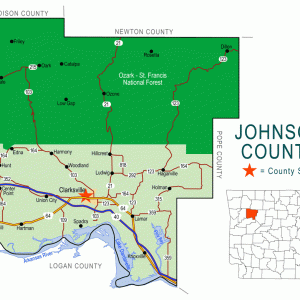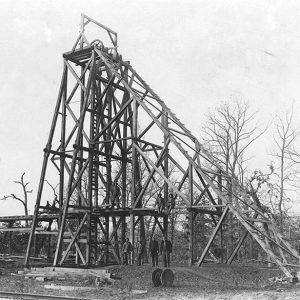calsfoundation@cals.org
Spadra (Johnson County)
When discussing Spadra, it is important to note that there are actually two locations to which the name applies: Spadra and New Spadra. Spadra, which was the earlier of the two towns, was the location of an Indian trading factory (a government-authorized trading post) and was the trading point for many settlers who moved into the area. It is the current location of the Spadra Marina, located on the Arkansas River. New Spadra was the location of the boom town that emerged many years later due to coal mining and the arrival of the railroad. The two can be difficult to separate in the historical record.
Louisiana Purchase through Early Statehood
The U.S. government established the Indian trading factory program in 1796 to maintain relations with Native American tribes. The Indian factory allowed the government to sell trade goods to the various tribes in return for furs through the use of factory managers and agents. Cherokee settlers came to Arkansas by 1800 and primarily lived along the Arkansas River; the government signed a treaty with them in 1817 and promised to establish a factory. The first factor was Isaac Rawlings, though he was almost immediately replaced by Barak Owens, who was never confirmed as the factor. Matthew Lyon, who is credited as the first official factor, arrived a year after the Indian factory was started around 1819. He stayed at the Spadra location until the Indian factory system was abolished in 1822. The buildings remained, and although it is not clear what happened to the buildings, some sources speculate that the Cherokee, against regulations, used the facilities. People from as far away as Carroll County would travel to Spadra/New Spadra to buy goods after the demise of the Indian trading factory. A historical marker, dedicated in 1984, sits on Spadra Bluff, near the original river town of Spadra.
While some white settlers did hunt and travel through the area (which was reserved for the Cherokee), most early settlers of Johnson County did not move into the area until after 1828, the year the Cherokee gave up their land. During the early periods of settlement, the most popular landing spots were at Morrison Bluff (Logan County), Pittsburg (Johnson County), and Spadra.
Initially, Spadra was the first county seat of Johnson County. As Clarksville (Johnson County) grew, it became the location for the county seat circa 1833. Spadra, as described in a land advertisement in 1840, was “situated in the centre of the rich and fertile county of Johnson, on the north bank of the Arkansas River, about four hundred and fifty miles from the Mississippi, one hundred and thirty-five miles above Little Rock, and one hundred miles below the Indian line, by the course of the river.” It was located along the bluff line with approximately a half-mile gradual rise back from the river.
Early Spadra settler E. B. Alston owned 1,400 acres of land on the west side of Spadra Creek, for which he built a bridge. In 1845, he built a new home site, which included his cotton gin and store. That gin and store were the beginnings of New Spadra.
Interestingly, the community of Spadra, California, was founded by William W. Rubottom, who had traveled to California from Spadra, Arkansas. According to a notice published in the Arkansas Gazette, offering $2,045 for Rubottom’s apprehension, on March 24, 1853, Rubottom murdered one James Murphy in Clarksville. He subsequently left for California and founded the settlement of Spadra near present-day Pomona. However, some later histories of the area credit Rubottom with leading a wagon train of 100 families from Arkansas to California with his brother, Ezekiel.
Civil War through the Gilded Age
Spadra, being part of Johnson County, most likely fared the same as the rest of the county during the Civil War. Though no major battles occurred in the county, there was plenty of contested ground throughout the area. With many areas held by the Union forces, the rural areas of the county, including Spadra, experienced guerrilla warfare.
Before the railroad moved into Johnson County in the 1870s, visitors and residents relied upon water transportation or used the county’s poor roads. With Spadra as one of four popular landing sites for transportation by water, it was visited by many different types of people: traders, settlers, visitors, and businessmen.
Spadra lost any chance of regaining its position as the county seat when the Little Rock and Fort Smith Railroad opted to go through Clarksville instead of Spadra. Clarksville had offered a financial proposition, leading the railroad surveyors to resurvey the area so that the railroad would go through Clarksville, even though this forced them to lose almost twenty miles of already placed track. New Spadra would ultimately emerge along the railroad track.
By the time the railroad came into the region in the 1870s, coal mining was already becoming a leading industry for Spadra and Johnson County, conducted in New Spadra, Coal Hill (Johnson County), Montana (Johnson County), and other small camp towns. Coal was initially discovered in 1840, near the east side of Spadra Creek. Both Arkansas anthracite coal, also known as the Spadra field, and bituminous types of coal can be found in Johnson County and, specifically, in Spadra. There were four primary mine shafts: the Johnson County Coal Company, the Scranton Coal Company, the Eureka, and the Clark-McWilliams. Coal mining, particularly the Spadra field, attracted both local residents and immigrants. Coal mining also brought labor unrest; from 1881 to 1886, two of the three strikes in Arkansas reported to the U.S. Commissioner of Labor occurred at Spadra.
In an event described widely as a lynching, Charles Jones was hanged in Spadra on October 31, 1881, following a very abbreviated jury trial.
Spadra had many of the major religious, political, and fraternal organizations of the time period, such as the Farmers’ Alliance, Knights of Pythias, Knights of Labor, and local orders of the United Mine Workers of America.
Early Twentieth Century through Modern Era
Spadra had its own local school building, which was maintained and improved as needed. In 1929, Spadra built a new school building. Spadra schools were consolidated into the Clarksville school system by 1949.
The Spadra Marina is in the approximate location of the original river town of Spadra. It is located south of Clarksville on the Arkansas River off Highway 103, just a few miles east on the railroad from New Spadra. Attractions at the marina, which has a tackle and bait store and a boat landing, include fishing, boating, and camping.
A well-known, isolated grave situated in a ditch in New Spadra is the burial place of G. W. Biggerstaff. The tombstone, located far from Spadra Cemetery, indicates that Biggerstaff was cruelly murdered on January 4, 1868. While some historians have speculated on the matter, the actual events surrounding his death remain unknown.
For additional information:
Alston, E. B. “The Town of Spadra.” Arkansas State Gazette, December 16, 1840, p. 1.
Baskett, Thomas S., Jr. “Miners Stay Away! W. B. W. Heartsill and the Last Years of the Arkansas Knights of Labor, 1892–1896.” Arkansas Historical Quarterly 42 (Summer 1983): 107–133.
Dollar, Clyde. “Archeological Site Survey Report on Spadra Factory.” Johnson County Historical Society Journal 1 (April 1977): 67–68.
“Historical Marker.” The Graphic, November 21, 1984, p. 14.
Langford, Ella Molloy. History of Johnson County, Arkansas: The First Hundred Years. Clarksville, AR: Johnson County Historical Society, 1976, 1981, 2010.
Logan, S. H. “Early Day Railroading in Arkansas.” Johnson County Historical Society Journal 18 (October 1992): 3–8.
Mickel, Lillian. The History of Johnson County Arkansas. Vol. 1. Clarksville, AR: Mrs. R. W. Mickel, 1983.
Jennifer Koenig Johnson
Bentonville, Arkansas






I’m attempting to find out which coal mine my maternal grandfather worked in near Spadra in 1930. My mother was born in Spadra. My husband and I have visited the area to attend family reunions and we have seen some monuments with some coal miners’ names on them. My grandfather’s name was Walter W. Stokes, but he went by W.W. Stokes.